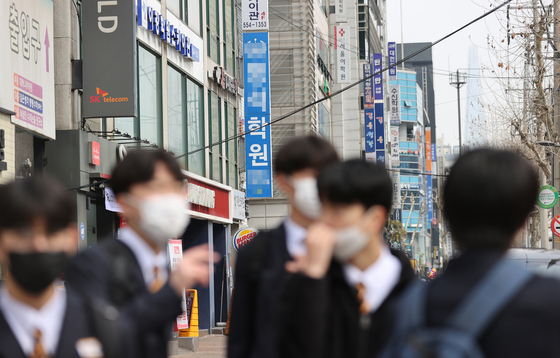
The school district in Daechi-dong, Gangnam-gu, Seoul is crowded with students on the afternoon of the 4th. yunhap news
Kim Mo, a 48-year-old working mother with a middle-aged son, was surprised when she entered her son’s room at a distance class early last year. My son, who thought he was listening to a teacher’s lecture online after closing the door, is playing a game with a different window on the monitor. Kim, who wanted to miss it, immediately attached a tutor. In the aftermath of the novel coronavirus infection (Corona 19), the private education that took a short break was resumed due to anxiety. Unless it was unavoidable that the business was suspended, I continued to send academy. Mr. Kim said, “Mothers with high-ranking children are anxious that now is an opportunity to improve their grades.”
Even if the household belt is tightened, the latest reduction in education costs is the cost of education, but it has not been able to avoid the effects of Corona 19. This is the effect of the closing of the academy, which was ordered to prohibit gatherings and restrict collection due to social distancing. However, even in the meantime, students who receive private education have increased their spending on private education.
According to the ‘2020 Elementary, Middle and High Private Education Expenditure Survey Results’ by the National Statistical Office on the 9th, the average monthly private education expenditure for all elementary, middle and high school students last year was 289,000 won. It decreased by 10.1% from the previous year’s average monthly private education expenditure (322,000 won). The rate of participation in private education also decreased by 7.9 percentage points from 74.3% to 66.5% over the same period. This is the result of a survey of 3,000 classes nationwide from March to May and July to September of last year. It is difficult to compare simply because annual data are not established, but it was analyzed that private education expenses, which increased for 7 consecutive years until 2019, fell for the first time last year.

Even if private education expenses were reduced, the number of students receiving increased. Graphic = Reporter Park Kyung-min [email protected]
The expenditure on education was also evident in the so-called’corona divide’. For students who participated in private education, the monthly average private education cost was almost unchanged from 433,000 won in 2019 to 434,000 won last year. Elementary school students (318,000 won) decreased by 9%, but middle school students (492,000 won) increased private education expenses by 2.5% and high school students (640,000 won) increased private education expenses by 5.2%. After-school schools, which have played a role of’safety plate’ to close the education gap, the participation rate decreased by 39.2% compared to the previous year.
The higher the household income, the higher the private education expenditure and participation rate continued. Households with an average monthly income of 8 million won or more also had the highest rate of participation in private education at 80.1% (504,000 won for private education). On the other hand, households with an average monthly income of less than 2 million won had the lowest private education participation rate at 39.9% (private education expenses 99,000 won).
It has not been confirmed whether students with high grades receive a lot of private education, and whether students who receive a lot of private education have good grades. However, the correlation was striking. The rate of participation in private education of students within the top 10% of grades was 71.8% (485,000 won for private education), but the participation rate of students within the lower 20% of the grades was 49.1% (270,000 won for private education). In terms of private education expenses by province, Seoul (829,000 won), Gyeonggi (688,000 won), and Daejeon (650,000 won) ranked top three in terms of high school students.
“Private education expenditures of students receiving private education have not decreased since statistics were written,” said Im Kyung-eun, head of the Welfare Statistics Division of Statistics Korea.
Sejong = Reporter Kihwan Kim [email protected]
![]()
